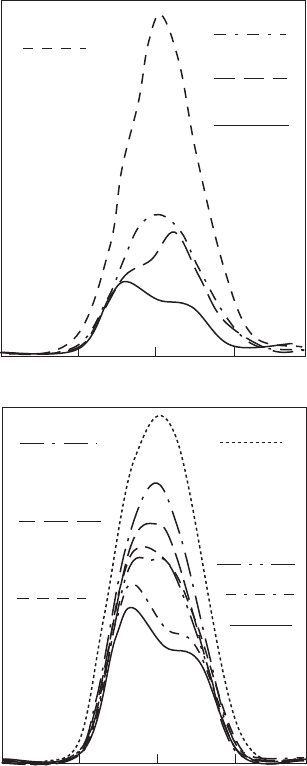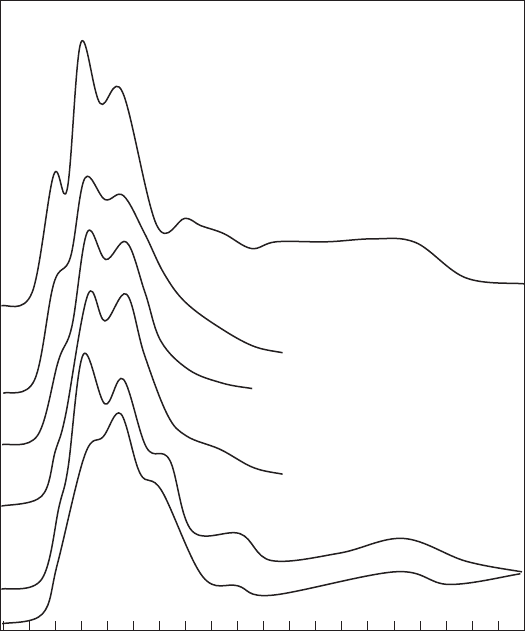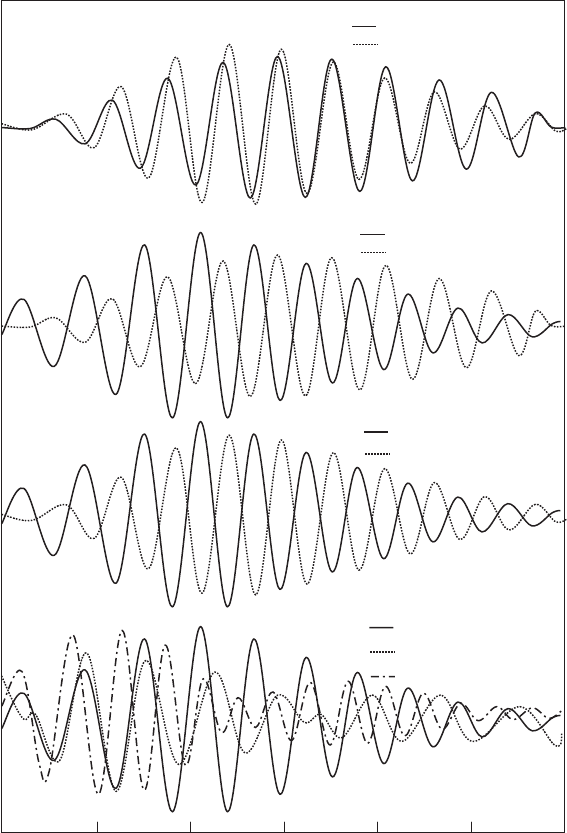Bergaya F. Handbook of Clay Science
Подождите немного. Документ загружается.

and larger distances are probed. Because an XAFS spectrum is taken over a range
of increasing X-ray energies, single- and multiple-scattering events dominate in
different portio ns of the spectrum. The higher energy portions of EXAFS spectra are
dominated by single-scattering events within only some tenth of nanometer
(500–600 pm) from the ab sorber, and contain information specific to the local struc-
ture surrounding the absorber. On the other hand, XANES or NEXAFS spectra,
being centred close to the absorption jump, are dominated by multiple-scattering
events extending a few nm from the absorber.
Comparisons of experimental Fe K EXAFS spectra with those calculated for
nontronites (derived from FEFF code (Rehr et al., 1991, 1992; Rehr, 2003)), indicate
that multiple-scattering events can be important at R*>450 pm (Manceau et al.,
1998), while co-linear multiple scattering events involving three or more high Z
atoms can be considerable at shorte r distances (Manceau et al., 2000a). Vantelon
et al. (2003) observed important amplitude differences in calculated Fe K EXAFS
spectra, incorporating multiple scattering, as compared with those that consider only
single-scattering events, especially in the 300–500 pm range. In modelling Al K
XANES spectra, Cabaret et al. (1996a) and Bugaev et al. (1998, 2000) found that
single-scattering events were unimportant.
B. XAFS Data Analysis
The procedures for XAS data processing (especially EXAFS) are standardised
(Stern and Heald, 1983; Rehr et al., 1991) and there are simplified, user-friendly
computer programs, such as IFEFFIT (Newville, 2003). Brown et al. (1988) and
Fendorf (1999) described XAFS data analysis methods suitable for use in c lay
and soil sciences, while detailed information on more diverse techniques was given
by Schulze et al. (1999), de Groot (2001), Bertsch and Hunter (2001) and Fenter
et al. (2002).
Spectral processing requires background and levelling corrections and energy
calibration. The amplitude of each spectrum must be normalised so that baseline
values of the amplitude function (m(E)) below the edge are near zero, and the
averaged value s of m(E) in the EXAFS portion are o1. Typically, a spline function
is applied to accomplish these steps (Fig. 12.3.1A). Energy and amplitude calibra-
tions must be performed because of ‘drift’ that occurs during data collection due to
differential heating of monochomators, beam instability and decay of the ring
current. The importance of these standardised ‘pre-conditioning’ treatments, and
their systematic and consistent application, cannot be stressed enough.
Analysis of XAFS spectra requires the extraction of data from the absorption
experiment. Owing to scattering interference and the limited mean free path of
the photoelectron, the magnitudes of X-ray scattering events typically decay rapidly
with increasing energy above the absorption edge (Fig. 12.3.1A). Therefore the
fine structure amplitude function, w(E), of an EXAFS spectrum is isolated from
Chapter 12.3: X-ray Absorption Spectroscopy796

post-edge background, m
0
(E), using the relation (Teo, 1986)
wðEÞ¼
mðEÞm
0
ðEÞ
Dm
0
ðEÞ
ð5Þ
where m(E) is the experimental absorbance as described above, m
0
(E) the atomic
contribution to the absorbance coefficient (X-ray absorption without the EXAFS
oscillations), Dm
0
(E) the measured absorption jump and E the kinetic energy of the
photoelectron (the difference in the energies of the X-ray and that needed to eject the
photoelectron into the continuum). Eq. (5) provides a means of normalising and
correcting background for all portions of the XAFS spectra, whether one’s interest is
in the pre-edge, the XANES or the EXAFS regions (Fig. 12.3.1A).
Pre-edge and XANES spectral analyses often involve the de composition and as-
signment of spectral features (Figs. 12.3.1B, C) and/or comparison with known
reference spectra (Ildefonse et al., 1994, 1998). During decomposition of spectra,
derivative curves can be used to locate abscissa where peaks occur. In common with
other quantitative spectral analyses, decomposition generally incorporates Gaussian
(normal) or Lorentzian (bell shaped) line shape functions, or Voigt (mixtures of
Gaussian an d Lorentzian).
For EXAFS (and NEXAFS) spectral analysis, the contributions of single- and
multiple-scattering events need to be quantified since these events give rise to am-
plitude modulations in the spectra. The oscillations in the EXAFS spectra can be
described quantitatively by
wðkÞ¼
X
j
N
j
f
j
ðkÞe
2k
2
s
2
j
kR
2
j
sin 2kR
j
þ d
j
ðkÞ
ð6Þ
Here N
j
is the number of atoms making up the jth shell, f
j
(k) the backscattering
amplitude function corresponding to each atom within shell j, d
j
(k) the total phase
shift function associated with the backscattering atom, s
j
2
the EXAFS Debye–
Waller factor for thermal and static disorder, indicating the variance about the
interatomic distances (R
j
) between the absorbing and backscattering atoms of the jth
shell. The wavenumber of the wavevector, k, is given by
k ¼
ffiffiffiffiffiffiffiffiffiffiffiffiffiffiffiffiffiffiffiffiffiffiffiffiffiffiffiffiffiffiffiffi
2mðE E
0
Þ
_
2
q
ð7Þ
where E
0
is now defined as the edge energy absorption threshold, usually located on
the edge at one-half Dm
0
(E)(Fig. 12.3.1A), m the electron mass and _ ¼ h=2p (h is
Planck’s constant). The backscattering amplitude function is specific to the atoms
involved in the backscattering process. The electronic terms, f
j
(k) and d
j
(k), in Eq. (6)
relate to the type of atom, while the terms N
j
, R
j
and s
j
are assocated with the
local arrangement of other atoms surroun ding the absorber. The EXAFS spectrum
therefore contains information on the number, identity and distance (72 pm) of
12.3.1. Synchrotron-Based Techniques 797

surrounding atoms as well as on the oxidation state and coordination number of the
absorbing atom. The task is to quantitatively extract N, R an d s from what is known
about the scattering amplitude f(k) and phase-shift d(k) of a given absorber and its
local chemical and structural environment.
The Fourier transform (FT) of Eq. (6) into ‘R’ space is defined as
k
w
ðwRÞ¼
1
2p
Z
1
1
dk sinð2kRÞk
w
wðkÞOðkÞð8Þ
where O(k) is a window function and w a k weighting factor. The w(k) wavevector
spectrum is multiplied by the weighting factors, k
w
, where w ¼ 1, 2, 3, y , to enhance
regions of high k (Fig. 12.3.1D ). Sometimes the same data are analysed using
different w weight factors (e.g., w ¼ 1 and 3; Manceau et al., 2000a). Window
functions, such as the ‘Hannel’ or ‘Kaiser-Bessel’ windows are applied to a selected k
range to truncate the ends of the spectrum, thereby minimising ‘termination ripples’
in the FT (Waychunas et al., 1986). These mathematical functions influence the
form of the EXAFS and ultimately the amplitude, phase and position of peaks in
the resulting FT (Fig. 12.3.1E)(Teo, 1986). Their systematic application is thus
important.
Peaks in the FT represent atomic shells, and are often complex combinations of
several different atomic shells. Polarised EXAFS (Section 12.3.1F) can help differ-
entiate between sub-shells making up particular peaks in the FT of layered materials,
such as smectites. In powder EXAFS (Section 12.3.1E), however, entire peaks are
used to determine the contributions of sub-shells to structural information. The
papers by Teo (1986), Brown et al. (1988), Fendorf (1999) and Newville (2003)
should be consulted for more detailed information on XAFS data processing.
The FT of an EXAFS spectrum (Fig. 12.3.1E) provides infor mation on the
distribution of atomic shells as a function of distance from the target absorber. By
isolating shells of interest and bac k transforming the selected k region into ‘q space’,
one creates a partial EXAFS spectrum that can then be compared to calculated
scattering (f ) and phase (d) functions in order to determine N, R and s associated
with that particular shell. The FT is sometimes referred to as radial distribution
(RDF) or radial structure (RSF) functions. Whatever the designation, they
rep resent sums of all possible pair correlations involving the absorbing atom
(Waychunas et al., 19 86). Since phase corrections are usually not included in the
FT, represented distances (R*) are generally 20–30 pm less than real interatomic
distances (R).
Care should be taken to ensure consistency during sample preparation because
differences in sample thickness and density can have a profound impact on the
XAFS amplitude, Dm
0
(E)(Stern and Kim, 1981; Waychunas et al., 1983; Lu and
Stern, 1993 ; Manceau and Gates, 1997). Disagreements over the interpretation of
various XAFS spectra were documented, such as the structures of Co
2+
-sepiolite
(Fukushima and Okomoto, 1987; Fukushima, 1988; Manceau and Decarreau, 1988),
Chapter 12.3: X-ray Absorption Spectroscopy798
tetrahedral Fe in ferrihydrite (Eggleton and Fitzpatrick, 1988; Combes et al., 1989a;
Manceau et al., 1990b; Drits et al., 1993; Manceau and Drits, 1993; Zhao et al., 1993,
1994; Manceau and Gates, 1997) and sorption complexes in oxides. These disagree-
ments may partly arise from differences in sample preparation and presentation. In
general, however, they can be attributed to variations in sample thickness and den-
sity, pre-analysis normalisation, data quality and the models used to interpret and
quantify the spectra. Although interpretational disagreements are an important and
necessary part of scientific research, they may cause considerable confusion for
novice XAS experimentalis ts and those who are not well acquainted with the lit-
erature. The potential for further confusion still exists.
C. Pre-Edge XAFS Spectroscopy
Features near the absorption edge are related to electronic transitions from core
states to empty bonding states. Oxygen 1s (K) XANES experiments and calculations
on transition metal dioxide (tetrahedr al) structures showed that filling of empty 3d
states in TiO
2
,VO
2
, CrO
2
and MnO
2
, are in agreem ent with experimental spectra
(de Groot, 2001) and correspond to increased 3d t
2g
state occupancies: 0 for Ti(IV), 1
for VO
2
, 2 for CrO
2
and 3 for Mn(IV). Pre-edge features are often observed in the
XAFS spectra of transition metal absorbers (Figs. 12.3.1A, B). Sometimes these
features represent intense dipole-allowed transitions, such as the 1s-3d transition of
tetrahedral Cr(VI) in CrO
4
2
(Sutton et al., 1993 ; Bertsch and Hu nter, 2001)orof
tetrahedral Fe (Waychunas et al., 1983), due to symmetry allowed p-3d state mix-
ing (de Groot, 2001). For octahedra l symmetry, dipole (e.g., 1s-3d) transitions are
forbidden (Calas and Petiau, 1983) although pre-edge features can be observed be -
cause the octahedral sites in most minerals are distorted, allowing some p-3d state
mixing. Waychunas (1987) showed that the amount of distortion-induce d p-d
mixing influences the amplitude and shape of the transition metal pre-edge features
for many minerals. Manceau and Gates (1997) observed this also in the Fe K pre-
edge spectr a of nanocrystalline ferrihydrite.
Fig. 12.3.3A shows the effect of site distortions for the Fe K pre-edge XAFS
spectra of goethite, hydrous ferric oxide and nontronite. Being a centrosymmetric,
trans-vacant, dioctahedral smectite, nontronite has a relatively weak pre-edge struc-
ture, depending on tetrahedral Fe content. Furthermore, the octahedral sites in
nontronite are only moderately distorted (Manceau et al., 1998) with a flattening
angle, b
FeyO
, of about 571. On the other hand, goethite (a-FeOOH) and hydrous
ferric oxide (HFO) can have appreciable octahedr al distortion due to hydroxylation
and hydration (Manceau and Gates, 1997; Ford and Bertsch, 1999). The increased
distortion of Fe octahedra in these two hydrous oxides results in 30–40% amplitude
enhancement compared with nontronite. Isomorphous substitutions of Al, Cr, Zn or
Cu for Fe in the structure of (hydr)oxides can result in considerable enhancement of
pre-edge amplitudes (Waychunas et al., 1986).
12.3.1. Synchrotron-Based Techniques 799

Energy (eV)
7090
7094 7098
Nontronite
αFeOOH
Fe
2
O
3
Normalized Absorbance
HFO
~30%
IV
Fe
~nil
IV
Fe
A
Ener
gy
(eV)
7090
7094 7098
Garfield
NG-1
G500
Normalized Absorbance
~30
V
Fe
~15%
IV
Fe
B
NAu-1
~nil
IV
Fe
NAu-2
Spokane
~10%
IV
Fe
~8%
IV
Fe
SWa-1
Fig. 12.3.3. Examples of Fe K pre-edge XAFS spectra showing differences in the 1s-3d
transition (t
2g
and e
g
) amplitudes and shape as a function of coordination environment and
site distortions. (A) Amplitude enhancement due to presence of tetrahedral coordination
(Fe
2
O
3
and FePO
4
), broadening due to multiple sites (Fe
2
O
3
) and amplitude enhancement due
to dispersion of FeyO distances and site distortion (FeOOH, HFO). (B) Amplitude en-
hancement due to incorporation of four-fold (NG-1) and five-fold (G500) Fe in the nontronite
structure. Also depicted is broadening due to distortions in the local Fe environment (G500).
G500 ¼ Garfield nontronite heated to 500 1C for 3 h. HFO ¼ hydrous ferric oxide, NG-1
Spokane, Nau-1 and Nau-2 are nontronite specimens with varying tetrahedral Fe content.
Modified after Manceau and Gates (1997) and Gates et al. (2002).
Chapter 12.3: X-ray Absorption Spectroscopy800
D. X-ray Near-Edge Spectroscopy (XANES or NEXAFS)
The processes responsible for near-edge absorption structure are related to ejection
of core electrons into ‘continuum states’, and involve single- and multiple-scattering
events off the first atomic shell surrounding the absorber, as well as multiple-
scattering events from more distant atomic shells (Fig. 12.3.1C). Edge features (po-
sition and shape) reflect oxidation states and coordination environments in the
vicinity of the absorber (Waychunas et al., 1983; Waychunas, 1987; Cressey et al.,
1993; Bajt et al., 1994, 1995; Ildefonse et al., 1994; Li et al., 1995; Delaney et al.,
1996a, 1996b; Wu et al., 1996; Gates et al., 1997; Manceau and Gates, 1997; Delaney
et al., 1998). This technique is now routinely applied to discern coordination and
oxidation states of metals in minerals at ng g
1
concentrations (e.g., Bertsch and
Hunter, 2001; Manceau et al., 2002a).
XANES spectra were traditionally interpreted by comparison with the spectra of
reference materials ( Waychunas et al., 1983; Waychunas, 1987; Bianconi, 1988;
McKeown et al., 1989; Ildefonse et al., 1994; Ildefonse et al., 1998). Decomposition
of the spectral components can indicate electron ‘density of states’ for the transition
metals (de Groot, 2001) as well as differentiate between different site symmetries
(Ildefonse et al., 1994, 1998; Bugaev et al., 1998, 2000) and assist in quantifying
oxidation states in various mineral species (Fig. 12.3.4)(Waychunas, 1987; Bajt
et al., 1995; Li et al., 1995; Delaney et al., 1996a, 1996b, 1998; Berry and O’Neill,
2004). Recent advances in multiple-scattering formalism, showed that XA NES
(NEXAFS) spectra can be treated like EXAFS spectra to gain element-specific
information on bonding environment, such as coordination number and inter-
atomic distances. Programs such as FEFF (Ankudinov et al., 1998; Rehr, 2003)or
SELCOMP (Bugaev et al., 1998, 2000), using self-consistent full-potential multiple-
scattering calculations, were instrumental in such advances. Simulations of multiple-
scattering events reveal that XANES spectra are generally well characterised by
nearest neighbour (single- and multiple-scatter ing events), next-nearest-neighbour
(multiple-scattering events) and next-next-nearest-neighbour (multiple-scatteri ng
events) intervals from the absorber.
Calculations by Cabaret et al. (1996a) indica ted that clusters with radii as large as
3 nm (30 A
˚
or 3000 pm) are necessary to effectively model Al K-XANES spectra.
Thus, even XANES spectra can provide short- to medium-range structural infor-
mation. Although this finding has yet to be fully exploited in clay mineral studies,
Bugaev et al. (2002) reported that Fourier filtering of XANES spectra can provide
quantitative information of coordination number and bond distances for both crys-
talline and short-range order compounds. Thus, detailed study of NEXAFS spectra
has the potential for more precise quantification than can be obtained from spectral
comparison of targe t atoms for which the absorption edges of other elements overlap
within the EXAFS region of the spectrum. Such situations disallow the collection of
sufficient data in k space (e.g., K edges of many 1st row transition metals overlap
with L edges of lanthanides) for satisfactory analysis to be carried out.
12.3.1. Synchrotron-Based Techniques 801

E. Powder EXAFS Spectroscopy
As already mentioned, the oscillations of an EXAFS spectrum result from inter-
ference between the outgoing ejected photoelectron wavefront and the scattered
wavefronts returning from near-neighbour environments. In clay structures, de-
structive interference occurs be tween waves backscattered from octahedral Fe and
octahedral Al (Fig. 12.3.5), because a near p -difference in phase shift exists between
3d (e.g., Fe, Mn, Ni) and 3p (e.g., Si, Mg, Al) elements (Waychunas et al., 1986;
Calas et al., 1990; Manceau, 1990). Similarly, a near p-difference in pha se shift
Energy (eV)
1570 15801560 1590 1600
Muscovite
Pyrophyllite
Kaolinite
Prassa Smectite
Oligocene Smectite
Illite
Al
IV
Al
VI
Al
VI
Fig. 12.3.4. Examples of Al K XANES (or NEXAFS) spectra of selected layer silicates.
Decomposition of the first three peaks at 1564, 1566–1567 and 1569–1570 eV allows quan-
titative estimation of tetrahedral Al content. Adapted and redrawn from Ildefonse et al.
(1994).
Chapter 12.3: X-ray Absorption Spectroscopy802

Fe-Al d = 303 pm
Fe-Si d = 328 pm
Fe-Fe d = 303 pm
Fe-Si d = 328 pm
Fe-Fe d = 303 pm
Fe-Al d = 303 pm
2 4 6 8 10 14 16
Wavevector k(Å
-1
)
Arbitrary k
3
χ(q)
Fe-Fe d = 303 pm
Fe-O d = 201 pm
Fe-O d = 378 pm
Fig. 12.3.5. Comparison of the calculated amplitudes and phases of nearest ligand (FeyO)
and cation (FeyFe, FeySi, FeyAl) atomic shell contributions to Fe K EXAFS spectra of a
typical smectite structure. Top panel: octahedral Al shell at d ¼ 303 pm and tetrahedral
Si shell at d ¼ 328 pm. Upper middle panel: octahedral Fe shell at d ¼ 303 pm and octahedral
Al shell at d ¼ 303 pm. Lower middle panel: octahedral Fe shell at d ¼ 303 pm and tetrahedral
Si shell at d ¼ 328 pm. Bottom panel: octahedral Fe shell at d ¼ 303 and O shells at
d ¼ 201 pm and d ¼ 378 pm. All waveform amplitudes were adjusted to differing degrees
relative to the FeyFe signal.
12.3.1. Synchrotron-Based Techniques 803

occurs between waves that are backscattered from tetrahedral a nd octahedral cations
of the same species, at least for the phyllosilicates (Manceau et al., 1998; Gates et al.,
2002). These phenomena were exploited to study octahedral cation occupancies in
Ni
2+
-smectite, Ni
2+
-sepiolite, montmorillonites, ferruginous smectites and non-
tronites and can be applied to kaolinite, pyrophyllite, allophane, imogolite and other
important minerals.
Powder EXAFS spectroscopy of clays and clay minerals does suffer from rather
severe limitations, however. One limitation is the difficulty in discriminating between
atoms of similar atomic number (Z), due to the similarity of their backscattering
wave functions (Fig. 12.3.5). While improvements were made in modelling these
contributions, it is still not possible to unequivocal ly differentiate between Al, Si and
Mg, or between Ni, Mn and Fe, as second cation-shell neighbours in a smectite
structure. Another limitation is the existence and complexity of multiple sites oc-
cupied by a given absorbing species (Table 12.3.1). For example, in magnetite with
an inverse spinel structure, Fe occupies both octahedral and tetrahed ral sites, and
has two different oxidation states. Strong overlap of the backscattering amplitudes
of tetrahedral and octahedral cations (Fig. 12.3.5) adversely affects quantitative
resolution between these two sites. Further, suitable reference materials with varied
coordination sites are lacking. For example, the five-fold coordinated Fe(III), Fe(II)
or Al in dehydroxylated structures of smectites is highly distorted (Rossman and
Tarlan, 2001; see Fig. 12.3.3 for Fe(III)). Vacancies (e.g., goethite), defects (e.g.,
ferrihydrite) and poor order (e.g., octahedral sheet of dioctahedral smectites) in
Table 12.3.1. Scattering paths used in fit of powder (film at a ¼ 351) Fe K EXAFS of SWa-1
displayed in Fig. 12.3.6. Single-scattering paths alone were found to enable a satisfactory fit
to determine N and R
eff
in IFEFFIT (Newville, 2003). Chemistry
y
and symmetry
z
were input
into TKATOMS (Ravel, 1999) to enable FEFF (Rehr, 2003) to determine scattering paths
Shell Scattering atom Path NR
eff
(pm)
FeyO
1
OFe-O-Fe 2 201
OFe-O-Fe 4 203
FeyM
1
Oct Al Fe-Al-Fe 0.7 301
Oct Fe Fe-Fe-Fe 2.3 307
Tet Si Fe-Si-Fe 4 337
FeyO
2
OFe-O-Fe 2 342
FeyO
3
OFe-O-Fe 2 371
OFe-O-Fe 4 388
FeyM
2
Tet Si Fe-Si-Fe 4 445
FeyInt Interlayer Na Fe-Na-Fe 2 510
FeyM
3
Oct Fe Fe-Fe-Fe 3 523
Fitting results: So
2
¼ 0:658; DE ¼ 25:58 eV; w
2
v
¼ 21. s was held constant at 0.07.
y
Chemistry from Gates (2004) or Gates et al. (2002).
z
c2/m.
Chapter 12.3: X-ray Absorption Spectroscopy804
mineral struc tures make unambiguous spectral interpretations the exception. In
layered structures, any preferential orientation will also affect the resulting EXAFS
amplitude, leading to misinterpretation. As already discussed, sample preparation,
presentation and spectral processing issues can also impact on the quality of the
XAFS spectrum and its interpretation.
EXAFS spectra can be quantified using IFEFFIT and associated program code
(Ravel, 1999, 2003a, 2003b; Newville, 2003), while scattering paths can be calculated
using TKATOMS (Ravel, 1999) and FEFF (Rehr, 2003). These programs incor-
porate the effects of curve waveforms and single- and multiple-scattering paths,
providing improved data analysis. The contributions of each scattering path within a
given distance from the absorber are calculated, and the resulting theoretical EXAFS
spectrum represents a sum of all these contributions. A scattering path defines the
atoms from which the photoelectron can scatter before returning to the absorber. As
described in Section 12.3.1A, single- and multiple-scattering paths occur, and based
on the crystallography of the mineral, calculated paths are used to deduce the atomic
shells surrounding the absorber. These are then compared to the experimentally
derived partial spectrum by applying least-squares analysis, which was back-
transformed from a peak isolated in the FT. The IFEFFIT code was recently
modified, allowing larger regions of the FT to be fit simultaneously. For such
methodology to be used effectively in the analysis of disorde red clay minerals, the
user must have as much detailed knowledge as possible of the crystal chemistry of the
specimen being studied, or be able to extract this information from known reference
materials. Thus, EXAFS is rarely a suitable stand-alone technique for unknown
samples. Most studies use a variety of other more conventional measurements into
which EXAFS is incorporated as a secondary or supplementary technique.
The powder EXAFS spectrum of the ferruginous smectite, SWa-1 (Fig. 12.3. 6 )
illustrates some of the pros and cons of fitting a large region (rather than isolated
peaks) of the EXAFS spectrum using IFFEFIT. Some different fits are shown, while
the results of one fit are displayed in Table 12.3.1. When the FeyM
1
shell was
isolated from the FT (Fig. 12.3.6, lower middle panel) fitting of the partial EXAFS
spectrum resulted in two octahedral components consisting of 2.1Fe at d ¼ 305 pm,
0.9Al at d ¼ 303 pm, and one tetrahedral component of 4Si at d ¼ 337 pm. A fit
of the entire FT from R* ¼ 0–600 pm results in 2.3Fe at d ¼ 307 pm, 0.7Al at
d ¼ 301 pm and 4Si at d ¼ 337 pm. Contrast these results with those of Manceau
et al. (2000a) and Vantelon et al. (2003) who studied the same mineral. The best fit of
the FeyM
1
shell in the latter study was 2.2Fe at d ¼ 309 pm and 0.8Al at
d ¼ 302 pm, not too dissi milar from the results in Table 12.3.1 (Fig. 12.3.6, bottom
panel). The best fit of the octahedral contributions to the Fe yM
1
shell by Manceau
et al. (2000a) was 2Fe at d ¼ 305 pm and 1Al at d ¼ 303 pm, similar to those dis-
played in Fig. 12.3.6 (lower middle panel). Since the octahedral contributions were
isolated using polarised EXAFS (P-EXAFS), the fits of Manceau et al. (2000a)
should be considered superior. This example also illustrates the importance of col-
lecting high k data for good accuracy on R
eff
. While the N
eff
determined by both
12.3.1. Synchrotron-Based Techniques 805
